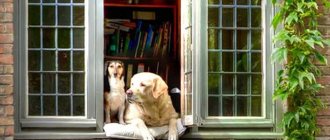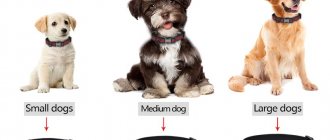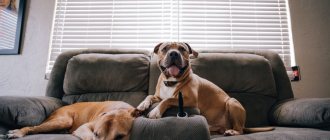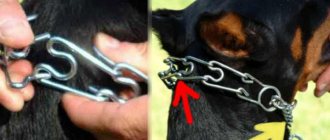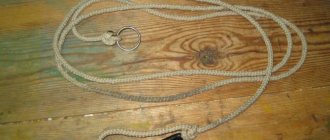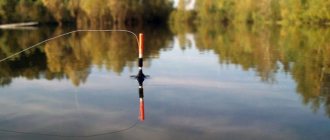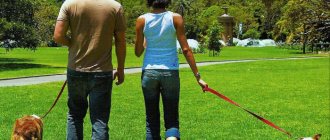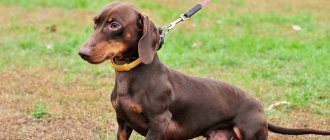Every person who decides to get a puppy must firmly understand their responsibility to the animal and to society. Many people think that raising a pet is not worth spending a lot of time on, but this is not true. You are lucky if the animal spent the first months of its life with a breeder who raises the baby from the first weeks of life, however, this does not always happen.
The first thing a new owner of a puppy faces is walking. Then the first and most important questions begin. The animal is not accustomed to the collar. How to deal with this situation and how to be able to accustom a dog to it will be discussed in this material.
Choosing equipment for a Labrador: buying a collar, leash
For comfortable and safe walks with your Labrador, you need to choose the right collar, leash, and harness.
To do this, you need to consider the types of equipment for large dogs. After purchasing a loving Labrador puppy, the owner must take care of choosing a suitable leash and collar for walking with his four-legged friend. The equipment should ensure the dog’s comfort and safety while being outside, training, or showing. In order not to get confused in the wide selection of pet products, you need to know how to choose a collar, leash, harness for both a puppy and an adult Labrador.
How not to make a mistake when choosing a collar size on Aliexpress?
When selecting any products on Aliexpress, you should always check the correctness of all the characteristics you have chosen several times. To do this, you should first look at the reviews. There you will find not only real photographs of the product, but also general recommendations for selecting the right size. For example, there you can find information about the parameters of pets for which you have already ordered similar collars and choose the right one. Still, the most effective way to check the sizes of dog collars on Aliexpress is to contact the seller directly.
Types of walking collars
Conventionally, all collars are divided depending on the purpose of use. Everyday collars are designed for walking a dog and identifying it as a pet. Everyday collars are made from a variety of materials: canvas, natural and artificial leather, nylon. When choosing a collar for a Labrador, you need to know that the dog needs to be accustomed to the equipment from the first walks. When going in search of the ideal collar for a pet, first measure the circumference of the puppy’s neck and add a few centimeters to the resulting value. Labradors grow rapidly in the first months of life, so the collar should have a small “reserve”. For puppies, it is better to purchase products made of nylon or canvas, since such collars are comfortable to wear due to their low weight. An adult dog can safely purchase any collar for large breeds that has reliable and wear-resistant fittings, in particular, a ring for a leash carabiner.
Everyday collars can also be equipped with additional elements that ensure the visibility of the pet over long distances. LED luminous collars will become an indispensable attribute for night walks with your Labrador. These products operate on batteries. Thanks to the LED collar, the owner will be able to track the pet at a distance of up to 500 meters.
Collars with reflective elements guarantee the safety of your Labrador while walking in the dark.
Pet health
Your little pet underwent anthelmintic treatments in the nursery three times: at ten days, at three weeks and at seven weeks. It will be necessary to give these drugs ten days before repeated vaccinations. The repeat is done three to four weeks after the very first vaccination.
Before leaving the breeder, the Labrador puppy received vaccinations against distemper, parvovirus enteritis, viral hepatitis and leptospirosis. To completely protect him from deadly diseases, a second vaccination is needed. Until it is delivered, quarantine is maintained. After vaccination, the puppy should not be walked outside for another two weeks and should not be allowed to have contact with other dogs. Be careful! After all, the disease virus can be transmitted on the soles of street shoes!
Raising and caring for a Labrador puppy at 3 months is no different from the previous age.
Follow feeding advice. In winter, give your pet fish oil as a source of vitamin D; in summer, wheat germ oil is recommended. Don’t get carried away, follow the dosage so as not to cause hypervitaminosis.
Up to six months, until the teeth are replaced, the puppy can gnaw on large beef bones as a toy. But for an adult Labrador this is dangerous - there is a risk of injury to the intestines. It's better to buy him bones from tendons at a pet store.
Collars for training
Labrador is a breed that requires training. For training with a dog handler, they purchase special equipment that allows them to control the dog during training. The most common training collars include:
Important: any training equipment is not suitable for everyday wear! Training choke collars are not used until the puppy reaches six months of age. Other types of equipment for training with a canine handler are suitable for Labradors older than 9 months.
Leash for Labrador
Today, dog owners are offered a wide selection of leashes. In order not to get confused in the wide range of such products, you need to know the classification of leashes depending on the purpose of use. A classic walking leash is purchased not only for adult Labradors, but also for puppies. The ammunition is made from various wear-resistant materials: leather, tarpaulin, nylon, nylon. The leash is equipped with a carabiner, thanks to which the product is connected to the collar ring.
When buying a walking leash for a Labrador puppy, you need to choose a product of moderate length. If the leash is too long, it will be difficult for the owner to control the behavior of a small, unintelligent pet while walking. Puppies must be carefully monitored outside, as they love to taste everything that lies on the ground - small pebbles, leaves, garbage. As an option, you can consider a fastening leash, equipped with several carabiners and rings, which allows you to adjust the length of the product.
An adult Labrador dog has large dimensions, so for such a pet, first of all, you need to purchase a reliable and strong leash with a high-quality carabiner that can withstand strong tension and heavy loads. The best option is a wide leash made of nylon or canvas.
For a large dog, we also recommend buying a leash-driver, which has the form of an elongated loop equipped with a carabiner for the collar. Such ammunition will come in handy if you need to move the animal across the road or past other dogs. The lead leash is very compact, so it easily fits in a pocket or small bag.
If your Labrador participates in dog shows, then you cannot do without a special exhibition leash. This type of equipment is called a ringovka, and the peculiarity of such a leash is its neutral color and minimum width, not exceeding 1 centimeter. Due to these characteristics, the show ring does not distract attention from the dog, which is very important during the exhibition. A show leash is not intended for walking!
Choosing a good jumpsuit for a Labrador
We recommend that you do this every time you have any questions about products on Aliexpress. Since each seller is directly interested in ensuring that you are completely satisfied with your order, they all try to get in touch as quickly as possible and advise all buyers.
You need to find a form to contact the seller and write him a message in English. In it, indicate your request and at the same time all the necessary data, the measurements you took and, in general, everything that you consider important. Sellers usually respond within an hour. Even if the response is delayed, the store will definitely contact you on the same day. They will tell you what size is best for you and you don’t have to check anything else, immediately follow the advice. Even if in the end this collar does not fit, you will quickly get your money back or replace the product, because you will have indisputable proof that it was the seller who advised you to make such a decision.
Found a mistake? Select it and press Ctrl + Enter
Does a Labrador Retriever need a harness?
A harness is an equipment that was developed for harnessing sled dogs, for example, Siberian Huskies. The design of the product provides comfort to the animal during heavy physical activity. Today, many Labrador owners use harnesses instead of a collar and leash. You can wear such equipment no earlier than 8-9 months, otherwise the pet may develop deformation of the front legs.
In order not to make a mistake when choosing a harness, you need to measure the following parameters of your Labrador:
Today, harnesses for large dogs are made from nylon, canvas and leather. A correctly chosen product will not cut into the dog’s skin and will not cause discomfort.
When purchasing ammunition for your Labrador, you need to give preference to trusted manufacturers who supply quality products for pets.
Source
Sled harness - Training and sports - Labrador.ru dogs
Totally agree with you! If your dog has good and regular exercise, then it makes sense to buy the right equipment. The weight harness is more convenient for the dog,
but less convenient for the owner (to store, carry). But I would like to draw your attention to the correct size of the harness itself. In the photographs (from Petra), you can see that the harness is sitting
on the dog is not correct (perhaps this is a defect in the design itself), the front part (“collar”) slides on the front paws, which will make it difficult for the dog to move.
I would like to note that towing (with well-fitted equipment) does not redistribute the load, i.e. The load on the hind and front legs does not change in percentage terms, as with normal running.
The increase in muscle mass or “drying up” of the dog depends, rather, on the exercises that the dog will do. Those. Light weights and long distances are more likely to dry out the dog than to build muscle mass.
Please tell me which weights are considered light?
Personally, I weigh the same as (on average) our Labradors weigh.
They are also used by children who weigh a little less.
I'm afraid to let someone heavier on the sled.
We have 2 types of sled harnesses, I think they fit our 2 younger dogs quite well.
pets, choice, care and education, catalog of companies, experts.
The law clearly states: dogs must be walked with a collar and leash, and large ones must also wear a muzzle. But few people think about the fact that a leash is essentially not a means of controlling a dog, but a means of controlling it where the animal should not run freely.
Quite often you can see a picture when a dog that has not been trained in the “near” command breaks free and wheezes, and the owner shortens the leash, wraps it around his hand and tries to restrain the disobedient pet.
A dog on a short leash can pull aside not only because it is not well-mannered: the dog wants to sniff some things, explore the territory, and communicate with other animals. Finally, the length of the leash may simply not coincide with the distance around the owner that the animal is trying to instinctively guard.
What are the dangers of leash tension?
When wearing a collar, all the pressure is taken on the animal's neck and throat, which causes problems with them. It has already been established that two thirds of back diseases and nervousness in dogs are caused by the collar-leash model in combination with jerking. This can also include diseases such as hypothyroidism, visual and hearing impairment, and damage to nerve nodes in the neck.
The throat of any animal is the most vulnerable place, and any pain here is perceived as a threat to life. A jerk on the throat causes aggression in a dog. As a result, it may turn out that your dog just wanted to get to know another person or relative better, but after pulling on the leash, he begins to bark. The owner doesn’t even need to pull the leash for this: the dog will do it itself. On any walk, jerks are inevitable.
Advantages of a harness over a leash
The harness distributes the load on the chest without causing pain. At the same time, it takes the load off the owner’s hands. It is much more difficult to keep a tearing dog in a collar than in a harness: the attachment of the leash to the harness is located in the area of the animal’s center of gravity, and when jerking, the dog loses its balance and can no longer press with all its weight. Of course, you need to train your pet to behave correctly and use the “here” command. But even if the dog constantly pulls to the side, in a harness he will never receive the injury that a collar would cause. For short-nosed dogs like pugs and bulldogs, a collar is generally contraindicated, as they already have difficulty breathing without it.
Finally, the harness increases the safety of walks: the back strap allows you to quickly grab your pet and restrain it from unwanted behavior. And a small dog can generally be lifted into the air by its harness without harm.
Useful tips
- Carefully choose the place and time for your first walk. It is advisable if it is an uncrowded, quiet place away from the roadway. If the area is located far from your home, it is better to carry the dog there in your arms for the first time so that the animal does not get scared and begin to get under the feet of passers-by.
- For the first time, do not plan long walks. to accustom a Labrador puppy to the street only gradually. Take into account seasonal and climatic features. should be calm and tired after a walk Fifteen minutes will be enough at first. Next, how long to walk your Labrador puppy depends on you. But, remember, your pet should breathe fresh air and run for a total of at least two hours a day.
- Gradually accustom and socialize the animal. You should not isolate him from other dogs. But be careful, danger can lurk in seemingly harmless things.
- Never let us “communicate” with stray dogs. At a minimum - fleas and serious illnesses. At the most, the dog can be bitten, or even tortured to death.
It is enough to follow these simple and simple rules, and your first walk will go with a bang. But you shouldn’t relax, because a long and difficult path awaits you on how to turn your pet into a well-mannered dog.
Leash or harness. What is best for a 2 month old Labrador?? Harness or leash.
Under no circumstances should you use a harness; when driving a puppy on it, your posture will form incorrectly, your back will hunch, and your elbows will turn out. Until the dog is fully formed, it should only be led with a collar.
Some breeds need to be led on a leash and some on a harness. A Labrador does not need a harness, even a small one; get him accustomed to a leash and collar right away.
why did you buy a dog? Even if you don’t know about the collar and muzzle, the harness and leash cannot replace each other, the harness and collar are attached to the leash.
Consult with the breed breeder. Actually, you already need to learn to wear a collar
Buy a good tape measure, you will need it for almost a year, or even more. You don’t need a harness, the dog is large, you’ll be flying in a month)))))
You don't need a harness, just a regular collar and leash, or a tape measure.
A Labrador cannot walk on a harness, this will spoil the exterior, especially in 2 month olds. puppy. The breeder should have explained this to you. Just a collar and a light leash, you can also buy a roulette leash.
In general, the leash is a fastening leather tape or chain. Every dog needs it. but you can choose between a collar and a harness. Do you have a very lazy dog and you have to drag him along with you? extreme case. clinic. take the harness. Is the puppy quite intelligent and runs next to you? Great, then a collar.
Are Labradors driven in a harness? In general, you can’t lead puppies in a harness; their posture will deteriorate; harnesses are only for mature, mature dogs.
harness, this way the cervical vertebrae are not injured and they develop normally and the puppy is comfortable
Totally agree with you! If your dog has good and regular exercise, then it makes sense to buy the right equipment. The weight harness is more convenient for the dog,
on the dog is not correct (perhaps this is a defect in the design itself), the front part (“collar”) slides on the front paws, which will make it difficult for the dog to move.
Please tell me which weights are considered light?
Personally, I weigh the same as (on average) our Labradors weigh.
They are also used by children who weigh a little less.
I'm afraid to let someone heavier on the sled.
We have 2 types of sled harnesses, I think they fit our 2 younger dogs quite well.
They fit quite tightly and do not fidget around the body.
Dogs do not feel discomfort when running.
And, judging by the current physical form, the loads are distributed quite evenly.
I would be grateful for an answer about weight.
Kat, I ride my child on a cargo harness, like this:
And when skiing, I harness Yuta to the sled, with a ring on his back
You come with your dog and try them on, they usually have a lot of sizes. If it doesn't fit, they will make it to order.
This is exactly the type of thing we have.
Riding and. another ride.
They were sewn to order, however, for Pascal (who now, of course, will not fit into any of them).
Our Cody is a monster! He, it seems to us, is in absolute delight when he pulls a sled with a passenger.
If things continue like this, we’ll do cany-cross + skijoring with him.
How to choose the right collar size for your dog
In a couple of weeks, focusing on the puppy’s wishes, you will increase the duration of the walk to half an hour 3 times a day (for example, at 9.00 - 15.00 - 21.00). An adult dog (from one year old) will walk in the morning and evening for an hour, and only during heat, again 3 times a day (but you can get by with a tray at home if it is not possible to walk during the day).
I advise you to walk on a leash for up to a year to avoid jumping out under cars and running after friends, until the puppy has firmly learned the commands “stop” and “come to me.”
IMPORTANT: always walk first, then eat. Physical activity on a full stomach can cause esophageal torsion in wide-chested dogs, which can either lead to death or a multi-hour operation with an unpredictable outcome.
So, let's take a walk and pay attention to the following points.
1. The main task during a walk is to move. The ideal walk for you and your dog is when you walk at a brisk pace while your dog trots (not gallops) alongside. You stop at 3-4 places for the toilet and somewhere on the lawn for 10-20 minutes you play outdoor games: a plate, a ball, throw a plastic bottle, a stick, etc. Closer to the year, it’s good to find a dog playground where the puppy can make friends with dogs and learn to overcome an obstacle course - a log, a ladder, a barrier.
2. In the second week of walks, begin to teach the puppy the necessary words: - stop, - come to me, - next (this means standing, sitting or walking at the owner’s left leg), - ugh, - car (the puppy must learn to pay attention to moving cars and avoid them), - to the lawn, - run, - home and others at your discretion. Say these words loudly and clearly, force them to do certain actions, praise them for the correct reaction and give them a treat. Learn words gradually, about one per week. Training may take several months, but then the dog will understand everything.
3. You need to let the puppy understand that he should do his business outside, not at home. Therefore, we sit him down on the grass (preferably 10 meters from the entrance, so that the dog can run close in case of emergency, and not confuse people). If he did something, we give him a treat. During the first month, we always reward people for doing things outside and express dissatisfaction with doing things at home (but we don’t remove the pallet for a few more months until it becomes permanently unnecessary). Hera still receives cookies for every major deed; this is a good tradition among us (or a cunning motivation when you need to shoot quickly and return home).
If the puppy settles down to make a pile not on the lawn (but on asphalt, etc.) - try to bring him to the grass with the words “on the lawn!” If you still made a bunch, put it in a plastic bag and grumble at the puppy, he understands everything. Be persistent, never leave heaps in the wrong places - and after a couple of months there will be no more mistakes, your route will always be clean, and you will avoid unpleasant conversations with car owners, young mothers and janitors, whose sphere of vital interests is invaded by your puppy's heaps.
4. The Labrador Retriever belongs to the hunting trail and gun breeds. Therefore, they are not afraid of loud sounds (firecrackers, fireworks), but they always search with their nose on the ground. You will have to make sure that the puppy does not eat anything found, so as not to harm his health. There are several ways to combat eating.
a) Scarecrow. When the puppy has found an old bone in the grass and has already opened its mouth, throw something heavy and loud, aiming for the bone. A bunch of keys, a piece of 3-4 link iron chain, etc. will do. It's okay if you hit him on the nose. This should discourage the puppy and, as a result, discourage him from picking up from the ground.
b) Painful shock. If the puppy picks up something, he is punished. This could be a click on a painful point on the nose, a strong shake by the collar, a shock from a stun gun on the collar. It’s better to trust specialists in order to get the effect in one go and not run into undesirable consequences (offense, character breakdown, etc.).
c) Muzzle. You take the coveted rotten meat out of your mouth, show it to the puppy and say: “You can’t, ugh, I’ll put a muzzle on!” and the rest of the walk he walks in a muzzle. The muzzle is needed in the form of a plastic mesh that is not adjacent to the muzzle. To buy one, you need to measure the length of the muzzle from the cavity between the eyes to the tip of the nose, and the girth around the jaws at the base of the muzzle. Don't use a leather muzzle because your dog will try to remove it and scratch his nose.
Of course, a muzzle is good for an already grown puppy, but at first you just have to constantly keep him in sight, don’t let him under bushes or behind garages, pull the leash when he’s about to pick up something, pull him out of his mouth, reprimand him and treat him philosophically to disobedience.
Upon returning from a walk, wash your paws. We tell the puppy: “sit, wash your paws.” He sits in the hallway wearing a collar. Attach the end of the leash to a hook on the wall or to a doorknob to avoid the temptation to run into rooms with dirty paws. Fill half a basin with cold water, wash and wipe the face, wash the front paws well in the basin between all the toes and up to the elbows, wipe dry between all the toes. Then the puppy stands up and you wash the hind legs up to the heels, butt and tail, and, if necessary, the belly. Then you unfasten the collar and say “go.” Only then can the puppy go into the rooms.
If it is wet and muddy outside, you will have to wash the puppy in the bath. Provide him with a two-stage bench (the kind sold at IKEA) and help him not to slip, so that in the future he will not be afraid of the bath. Labradors love water, so there should be no problems with washing them. Wash in a warm shower with dog shampoo, without getting the face and ears, and dry thoroughly. Remember that the dog will definitely shake itself off after washing, wait for this moment in the bathroom, and only then let it out into the rooms, otherwise you will end up with a shower for furniture and wallpaper.
To avoid a lot of washing, you can buy a couple of raincoat overalls to protect against dirt and wash them every time. But it makes sense to do this when the dog grows to a permanent size.
Enjoy your walks and mutual understanding with your puppies
